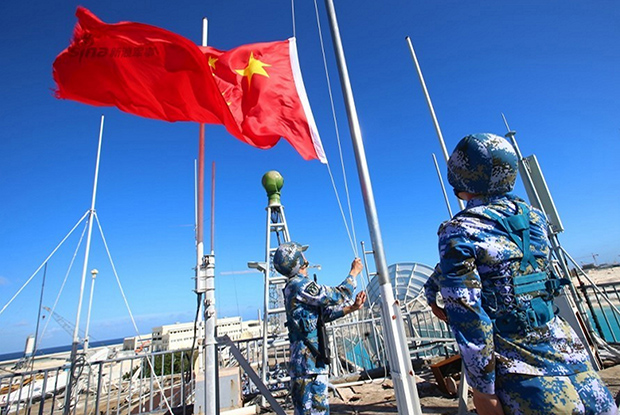
Over the last two years, China’s activities in the South China Sea have attracted worldwide attention and suspicion. The communist state illegally claims a vast portion of the South China Sea as its territorial waters, and efforts to create land on the high seas have become increasingly militaristic.
In 2014, China accelerated a land reclamation program focused on the Paracel Islands, Spratly Islands, and Scarborough Shoal.
The program involves removing sediment from the bottom of the sea and piling it on coral reefs to create new landmasses. These newly built islands—Mischief Reef, Subi Reef, Fiery Cross Reef, Cuarteron Reef are some of their names—have since become construction sites for both civil and military infrastructure projects.
In February, Adm. Harry B. Harris Jr., head of US Pacific Command, told the Senate Armed Services Committee, “In a little over two years, China has constructed more than 3,000 acres of artificial land” in the South China Sea.
Satellite imagery shows these new geographical features are now home to airstrips long enough to land military bomber and fighter aircraft, build lighthouses, substantial support buildings, and military-grade radar facilities. Aerial photos also show the Chinese have dredged large areas to create harbors that can service naval ships.
Harris called the program “a strategic frontline in [China’s] quest to dominate East Asia” and warned, “These events threaten the region’s peace and prosperity.”
Many Disputes
Jason Thomson, writing in The Christian Science Monitor, believes China has already established a “strategic triangle” for influence in the South China Sea. Foreign Affairs’ Mira Rapp-Hooper sees China’s strategic goal as that of creating “an anti-access, area-denial (A2/AD) capability that aims to keep foreign powers from entering or operating in the waters close to its shores in the event of a major conflict.”
The South China Sea expansion has created a series of territorial disputes with China’s neighbors Vietnam, the Philippines, Malaysia, and Indonesia. While Harris noted some of these disagreements date as far back as 1974, the escalated pace of China’s construction efforts has opened fresh controversy.
The Philippines recently brought a case against China before an international tribunal at The Hague, which ruled on July 12 that China’s claims over much of the South China Sea have no historical or legal validity.
This ruling was unequivocal, but enforcing its outcomes will be difficult. The court’s power rests on broad acceptance of the current international system, but “China’s actions undermine the international rules-based order,” according to Harris.
Indeed, The Wall Street Journal reports that Beijing has been unrepentant since the tribunal’s judgment, with the Chinese military announcing on Aug. 7 that it had flown H-6K bombers and Su-30 fighter jets over the Spratly Islands and Scarborough Shoal. The newspaper quoted a Chinese air force spokesman as stating that the patrol was “to enhance combat capabilities to deal with various security threats.” This development affirms the Defense Department’s assessment, in its 2016 “Annual Report to Congress” on China, that the nation has used low-intensity coercion to enhance its presence and control in disputed areas of the East and South China Sea.”
The mere existence of the artificial islands and their associated infrastructure makes it difficult to roll back China’s claims in the region.
Concern about the reef building is not just about military presence and intimidation. Beijing’s expansion into the South China Sea is also an attempt to extend the nation’s economic interests at other nations’ expense, by creating claims to the fishing grounds, oil, and other natural resources in the sea in general and around the reefs and shoals in particular.
PACOM’s Harris said a proper response to the situation “requires national resolve and a willingness to apply all elements of national power.” As an example, he pointed to 2016 freedom of navigation operations in which US Navy ships sailed close to disputed Chinese reefs to demonstrate international freedom of the seas. He also announced the availability of $425 million in DOD funding to support Secretary of Defense Ashton B. Carter’s Southeast Asia Maritime Security Initiative, which seeks to strengthen military-to-military relationships in the region.
After the latest freedom of navigation operation in May, however, the Chinese air force scrambled fighter jets, complicating the way forward for US strategy on the South China Sea.
China’s government and air forces have behaved recklessly in the region in the recent past, and unless Beijing accepts international law in the South China Sea it is entirely possible that armed conflict could break out because of these artificial islands in international waters.